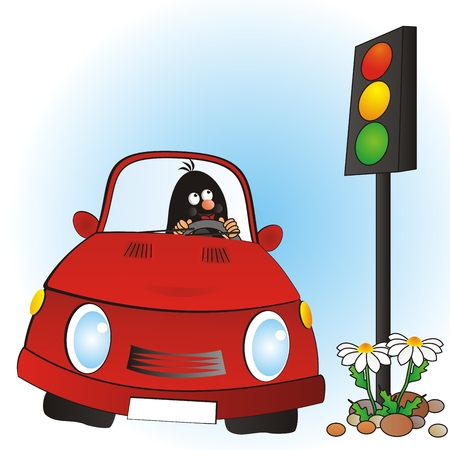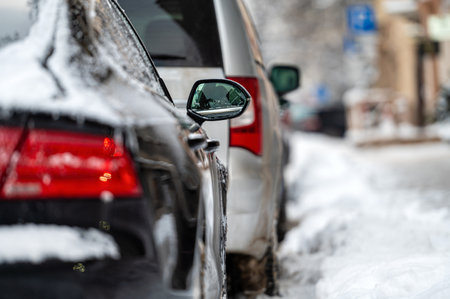1. Introduction to Safe Following Distances
Understanding the importance of maintaining a safe distance between vehicles is essential for preventing accidents. When driving, keeping a proper following distance allows you enough time to react in case the vehicle in front suddenly slows down or stops. Failing to maintain a safe distance can lead to rear-end collisions, which are among the most common types of accidents on the road.
Why Maintaining a Safe Following Distance Matters
The space between your vehicle and the car ahead gives you time to assess the situation, apply the brakes, and avoid potential collisions. The faster you drive, the longer it takes to stop, which means your following distance should increase accordingly.
Recommended Safe Following Distances
A useful rule for determining a safe following distance is the “three-second rule.” This rule suggests that you should pick a fixed object on the road (such as a sign or a tree) and count how long it takes for your vehicle to pass it after the car in front of you has passed. If it takes less than three seconds, youre too close. During bad weather or poor visibility, increasing this to four or five seconds is recommended.
Minimum Following Distance Based on Speed
| Speed (mph) | Minimum Following Distance (Seconds) |
|---|---|
| Under 35 mph | 3 seconds |
| 35-55 mph | 4 seconds |
| Over 55 mph | 5 seconds or more |
Factors That Affect Safe Following Distances
- Speed: The faster youre traveling, the more distance you need to stop.
- Weather Conditions: Rain, snow, and fog reduce traction and visibility, requiring more space.
- Road Conditions: Gravel, potholes, and wet roads affect braking ability.
- Vehicle Type: Trucks and SUVs need more stopping distance than smaller cars.
- Reaction Time: Driver attentiveness plays a crucial role in reacting to sudden stops.
How to Ensure Youre Keeping a Safe Distance
To make sure youre following at a safe distance, regularly check your spacing by using the three-second rule. Adjust for road conditions and always be prepared to increase your following distance in case of poor weather or heavy traffic.
2. Understanding Safe Following Distances and Reaction Times
2. The Role of Reaction Time in Driving
Reaction time plays a crucial role in driving safety. It refers to the time it takes for a driver to recognize a hazard and begin taking action, such as pressing the brake pedal. The average drivers reaction time is about 1.5 seconds, but this can vary based on factors like fatigue, distractions, and driving experience.
How Reaction Time Affects Stopping Distance
Stopping distance is the total distance a vehicle travels from the moment a driver detects a hazard until the car comes to a complete stop. It consists of two main components:
1. Reaction Distance
Reaction distance is the distance your vehicle travels during your reaction time. It depends on your speed—if youre driving faster, your vehicle will cover more ground before you even begin braking.
2. Braking Distance
Braking distance is the distance your car travels after you apply the brakes until it stops completely. Factors like road conditions, weather, and vehicle weight can affect braking distance.
Reaction Time and Stopping Distance at Different Speeds
The table below shows an estimate of how reaction time and braking distance impact total stopping distance at various speeds:
| Speed (mph) | Reaction Distance (ft) * | Braking Distance (ft) ** | Total Stopping Distance (ft) |
|---|---|---|---|
| 30 | 45 | 45 | 90 |
| 50 | 75 | 125 | 200 |
| 70 | 105 | 245 | 350 |
* Based on an average reaction time of 1.5 seconds.
** Braking distance can vary depending on road and vehicle conditions.
Improving Reaction Time for Safer Driving
Since reaction time directly impacts stopping distance, improving it can enhance driving safety. Here are a few tips to help maintain a quick reaction time:
Avoid Distractions
Keep your eyes on the road and avoid using your phone, eating, or engaging in activities that take your focus away from driving.
Stay Well-Rested
Fatigue slows reaction time significantly. Ensure youre getting enough sleep before driving.
Maintain Vehicle Brakes
Worn-out brakes can increase braking distance, making stopping even harder. Regular maintenance is essential for safe driving.

3. Factors That Influence Following Distance
Maintaining a safe following distance is about more than just keeping a set number of car lengths between you and the vehicle ahead. Several factors can impact how much space you need to stop safely and avoid collisions. Let’s look at some key variables that influence following distance.
Speed
The faster you drive, the longer it takes for your vehicle to stop. Higher speeds increase both the distance your car travels while you react and the braking distance required to come to a full stop. The general rule is the “three-second rule” at lower speeds, but more space is needed as speed increases.
Weather Conditions
Weather conditions such as rain, snow, fog, or ice can significantly impact stopping distances. Wet or icy roads reduce traction, making it harder to stop quickly. In poor weather, increasing following distance is essential for safety.
Road Conditions
Road conditions also play a role in how much space you should leave. Potholes, gravel, and uneven pavement can reduce tire grip, while steep hills can make stopping more difficult. Be aware of road hazards and adjust your following distance as needed.
Driver Awareness
Your reaction time depends on how alert and focused you are. Distractions like texting, fatigue, or impairment reduce your ability to respond to sudden braking. Staying fully attentive while driving helps ensure you can react quickly when needed.
Effect of Different Conditions on Stopping Distance
The table below shows how various factors impact stopping distance:
| Factor | Effect on Stopping Distance |
|---|---|
| Speed Increase | Longer stopping distance |
| Wet or Icy Roads | Requires more space to stop safely |
| Poor Road Conditions | Reduced traction and stability |
| Driver Distractions | Slower reaction time, increasing distance needed |
Understanding the factors that influence following distance allows you to make smarter driving decisions based on your speed, weather, road conditions, and awareness level. By adjusting your following distance accordingly, you improve road safety for yourself and others.
4. Recommended Following Distance Guidelines
The Three-Second Rule
One of the simplest and most widely recommended methods to maintain a safe following distance is the three-second rule. This rule helps drivers adjust their distance based on speed and road conditions. Heres how it works:
- Pick a stationary object on the road ahead, like a road sign or a bridge.
- When the vehicle in front of you passes that object, begin counting, “one thousand one, one thousand two, one thousand three.”
- If you reach the object before finishing the count, you are too close and should increase your distance.
This rule applies in ideal driving conditions. However, certain situations require increasing this following distance.
When to Increase Your Following Distance
While the three-second rule works for normal conditions, you may need to extend the gap in other situations. Below are common scenarios where more distance is necessary:
| Condition | Recommended Following Distance |
|---|---|
| Wet or slippery roads | At least 4 seconds |
| Low visibility (fog, heavy rain, or snow) | At least 5 seconds |
| Following a large truck or bus | 4-5 seconds |
| Driving at high speeds (highways and freeways) | 4+ seconds |
| Nighttime driving | At least 4 seconds |
Increasing your following distance gives you more time to react in case the vehicle ahead suddenly stops or slows down.
Guidelines from Safety Organizations
Safety organizations, such as the National Highway Traffic Safety Administration (NHTSA) and the American Automobile Association (AAA), consistently emphasize the importance of maintaining adequate following distances. They recommend:
- Following the three-second rule under normal conditions.
- Extending to at least four seconds in adverse conditions.
- Leaving extra space when driving larger or heavier vehicles, which require more stopping distance.
- Avoiding tailgating, as it significantly increases the risk of accidents.
By adhering to these guidelines, drivers can reduce the likelihood of rear-end collisions and ensure a safer driving experience for everyone on the road.
5. Five. How to Improve Reaction Time and Safety
Maintaining a safe following distance is crucial, but reacting quickly and appropriately to sudden changes in traffic conditions is just as important. Here are some practical tips to help improve your reaction time and overall driving safety.
Stay Alert at All Times
Being mentally and physically alert is key to quick reaction times while driving. Here are some ways to stay sharp behind the wheel:
- Get enough rest: Fatigue slows down your response time. Make sure you’re well-rested before driving, especially for long trips.
- Avoid driving under the influence: Alcohol and drugs impair judgment and reaction time. If you’ve consumed any impairing substances, don’t drive.
- Stay hydrated and eat properly: Dehydration and hunger can cause fatigue and sluggish reactions.
- Be aware of your surroundings: Constantly scan the road ahead, behind, and around you to anticipate potential hazards.
Reduce Distractions
Distractions are one of the leading causes of delayed reaction times. Minimizing them helps you stay fully focused on the road.
| Distraction | How to Avoid It |
|---|---|
| Cell Phones | Use hands-free features or put the phone away while driving. |
| Eating or Drinking | Eat before driving or pull over if necessary. |
| Adjusting Music or GPS | Set up your GPS and music before you start driving. |
| Conversations with Passengers | Keep discussions brief and avoid heated debates while driving. |
Practice Defensive Driving Techniques
Defensive driving helps you anticipate problems and react faster. Here are some key techniques:
- Keep a safe following distance: Follow the three-second rule under normal conditions and increase it in bad weather.
- Expect the unexpected: Assume other drivers might make mistakes and adjust accordingly.
- Don’t speed: High speeds shorten reaction time and increase stopping distance.
- Use your mirrors often: Check your mirrors regularly to be aware of surrounding traffic.
- Plan for escape routes: Identify open spaces or lanes to move into if an emergency arises.
Stay Prepared and Stay Safe
Improving your reaction time and driving safety is all about preparation, awareness, and good habits. By staying alert, minimizing distractions, and using defensive driving techniques, you can better protect yourself and others on the road.


